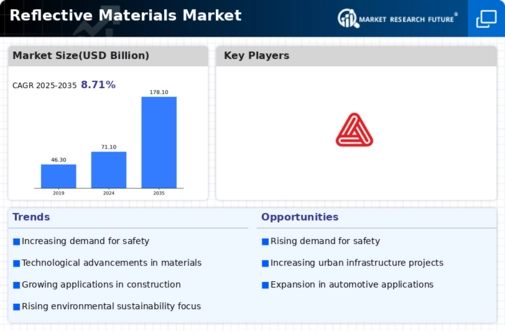Top Industry Leaders in the Reflective Materials Market

The reflective materials market is a dynamic arena fueled by innovation and fierce competition. From high-visibility clothing for construction workers to road signs enhancing nighttime safety, reflective materials permeate various industries. Understanding the competitive landscape is crucial for both established players and aspiring entrants seeking a foothold in this promising market.
Strategies for Market Domination:
- Innovation: Leading companies like 3M and Avery Dennison are constantly pushing the boundaries with novel materials and technologies. Examples include microprismatic films offering superior reflectivity at wider angles and fabrics woven with reflective yarns for enhanced comfort.
- Product Diversification: Diversifying product portfolios caters to specific needs across various applications. This includes offerings for apparel, signage, automotive components, and even decorative elements. Companies like Reflexite Corporation are adept at tailoring their products to diverse industries.
- Geographical Expansion: Emerging economies in Asia-Pacific and Latin America present lucrative opportunities. Establishing a strong presence in these regions through partnerships, acquisitions, or local manufacturing facilities is a key strategy for global players like HALOGEN Security Solutions.
- Sustainability Focus: Eco-conscious consumers are driving demand for sustainable reflective materials. Companies like Tesa are developing solutions made from recycled materials or with reduced environmental impact during production and disposal.
- Digital Integration: Integrating digital technologies like near-field communication (NFC) into reflective materials opens up new possibilities. Imagine clothing embedded with reflective tags that unlock information or trigger actions upon scanning. Companies like DuPont are exploring such integrations.
Factors Influencing Market Share:
- Product Quality and Performance: The effectiveness of reflective materials in specific applications plays a crucial role in market share. Superior reflectivity, durability, and adaptability to diverse environments are key factors.
- Price and Cost-Effectiveness: Balancing quality with affordability is crucial, particularly in price-sensitive segments like signage or construction apparel. Companies like Reflex Inc. focus on offering cost-effective solutions without compromising on performance.
- Brand Reputation and Trust: Established brands with a proven track record of quality and reliability have an edge in the market. 3M's Scotchlite™ reflective material is a prime example of a trusted brand name influencing purchasing decisions.
- Distribution Network and Customer Service: Efficient distribution channels and responsive customer service ensure timely product delivery and address customer concerns effectively. Companies like ORAFOL International are known for their robust distribution networks.
- Regulatory Compliance: Adherence to regional and international safety standards like EN 13356 for high-visibility clothing is essential for market acceptance. Companies invest heavily in ensuring compliance to remain competitive.
List of Key Players in the Reflective Materials Market
- 3M (US)
- Avery Dennison (US)
- ORAFOL Europe GmbH (Germany)
- Dominic Optical (China)
- Coats Group ple (UK)
- Asian Paints PPG (India)
- NIPPON CARBIDE INDUSTRIES CO. INC. (Japan)
Recent Developments:
September 2023: HALOGEN Security Solutions announces plans to expand its manufacturing facility in India to cater to the growing demand in the Asia-Pacific region.
October 2023: 3M introduces a new high-performance reflective film with improved visibility at extreme angles, ideal for road signage and traffic safety applications.
November 2023: DuPont unveils a prototype smart jacket with embedded reflective elements that trigger safety alerts when approaching hazardous environments.
December 2023: Reflex Inc. launches a cost-effective line of reflective workwear, targeting price-sensitive segments in the construction and transportation industries.

